 Our friends Jill and Bruno are, like us, a French-British couple only the other way round – Jill is British and Bruno is French. They live close to us on the Isle of Man and Bruno is a talented painter. We have one of his prints at home in France – ‘Walking the Dogs’ – that I adore because it really captures the essence of Peel (or Sunset City as the locals like to call it). But not only is Bruno a talented guy, he’s also a very genuine guy – as are they both.
Our friends Jill and Bruno are, like us, a French-British couple only the other way round – Jill is British and Bruno is French. They live close to us on the Isle of Man and Bruno is a talented painter. We have one of his prints at home in France – ‘Walking the Dogs’ – that I adore because it really captures the essence of Peel (or Sunset City as the locals like to call it). But not only is Bruno a talented guy, he’s also a very genuine guy – as are they both.
Now, living in another country is fine but can leave you with strange ‘holes’ in your way of living since you begin to miss some of the things you were brought up with. Marie-Danielle and I are lucky because we move between the two cultures twice a year so we can get a regular “fix” of the things we like. For me, it’s little things like Salad Cream, Scotch Eggs and Corned Beef that simply aren’t available in France (I take several bottles of Salad Cream back with me!). It’s not that I miss them terribly, it’s just that it would be nice to be able to treat myself once in a while.For M-D, she misses being able to buy confit and veal (yes, I know veal is available in mainland UK, but this the Isle of Man where, for reasons I have never been able to fathom, veal is not available. But, as I say, M-D and I can ‘catch up’ on a fairly regular basis.
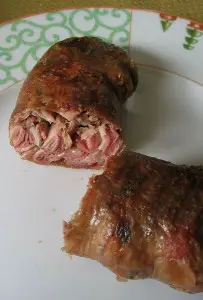 Bruno has the same “challenges” and one of the things he misses is that famously French sausage called andouillette. Andouillette is a coarse-grained sausage made with pork intestines (or chitterlings, as we know them in Britain) pepper, wine, onions, and seasonings. True andouillette is shaped like an oblong tube. If made with the small intestine, it is a plump sausage generally about 1″ (2.5cm) in diameter but often it is much larger and stronger in scent when the colon is used. The andouillette has a strong, distinctive odour related to its intestinal origins and component parts. In fact, it is this odour (and subsequent taste) that turns me off this “delicacy”. I have tried eating bits of them several times, but simply do not appreciate them as many in France do. We all have foods like that, which simply don’t “suit” us.
Bruno has the same “challenges” and one of the things he misses is that famously French sausage called andouillette. Andouillette is a coarse-grained sausage made with pork intestines (or chitterlings, as we know them in Britain) pepper, wine, onions, and seasonings. True andouillette is shaped like an oblong tube. If made with the small intestine, it is a plump sausage generally about 1″ (2.5cm) in diameter but often it is much larger and stronger in scent when the colon is used. The andouillette has a strong, distinctive odour related to its intestinal origins and component parts. In fact, it is this odour (and subsequent taste) that turns me off this “delicacy”. I have tried eating bits of them several times, but simply do not appreciate them as many in France do. We all have foods like that, which simply don’t “suit” us.
Although sometimes repellant to the uninitiated, the strong odour and taste of andouillette is prized by its devotees (like Bruno and M-D). Since true andouillette is rarely seen outside France (and certainly never on the Isle of Man!), we brought some back with us and decided to “treat” Bruno to an andouillette evening!
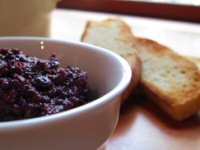 We didn’t do a starter course as such, we simply ‘extended the choices’ of the aperitif. In addition to the usual olives and nibbly biscuits, we provided some slightly more ‘substantial’ fare like quails eggs and toasts with homemade tapenade on them. This way of starting a meall allows friends to sit in comfortable chairs around a low table and chat whilst beginning the eating process.
We didn’t do a starter course as such, we simply ‘extended the choices’ of the aperitif. In addition to the usual olives and nibbly biscuits, we provided some slightly more ‘substantial’ fare like quails eggs and toasts with homemade tapenade on them. This way of starting a meall allows friends to sit in comfortable chairs around a low table and chat whilst beginning the eating process.
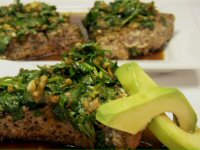 And so to the pièce de résistance, the main course! I believe I’ve mentioned before on this blog that Jill is not vegetarian, but she won’t eat anything that had four legs when it was alive. She’s fine with poultry and fish so I did Pan-Seared Tuna with Avocado, Soy, Ginger, and Lime for the two of us while Bruno and Marie-Danielle got stuck into their andouillettes. The tuna is easy to prepare and takes 2 minutes to cook. The andouillette is ready-made and cooks almost on its own in a pan for 10-12 minutes. A handful of oven chips, a dish of Dijon mustard and a side salad was all we needed to create a main course that pleased all its participants. It doesn’t have to be complex to be a winner! But have you ever seen a grown man cry!!! Bruno was in Bruno heaven and didn’t want to come back down to planet earth!
And so to the pièce de résistance, the main course! I believe I’ve mentioned before on this blog that Jill is not vegetarian, but she won’t eat anything that had four legs when it was alive. She’s fine with poultry and fish so I did Pan-Seared Tuna with Avocado, Soy, Ginger, and Lime for the two of us while Bruno and Marie-Danielle got stuck into their andouillettes. The tuna is easy to prepare and takes 2 minutes to cook. The andouillette is ready-made and cooks almost on its own in a pan for 10-12 minutes. A handful of oven chips, a dish of Dijon mustard and a side salad was all we needed to create a main course that pleased all its participants. It doesn’t have to be complex to be a winner! But have you ever seen a grown man cry!!! Bruno was in Bruno heaven and didn’t want to come back down to planet earth!
We finished off with one our favourites (also extremely simple), Orange Carpaccio with Gâteau Creusois. It was a pleasant evening spent with two good people. I suspect we may be hauling back more andouillettes next time we return from France.
We head back to France in less than two weeks, but we’re not done eating yet! Tomorrow, Steve and Jeanette (brother and sister-in-law) have invited us to a little restaurant perched on the cliffs just down the coast. The day after, Terry and Julie are hosting “the big six” (themselves, us and two other friends from over the road) to dinner at theirs. The following Saturday, Penny and Steve (who joined us on Christmas Eve) have invited us to eat at theirs. And a day or two later, the evening before we leave, we’ll be at Bruno and Jill’s, enjoying crêpes for La Fête de la Chandeleur. And then I go on a diet – that’s if France will let me!
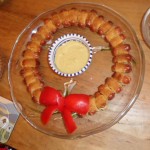 What we didn’t know when we planned to hijack Terry’s birthday was that it was Julie’s birthday on 31st December. And what they didn’t know (until M-D told them) was that it’s mine on 6th January. So you can imagine that the aperitif was more alcoholic than normal (and normal is pretty good!). We repeated a little fun presentation that we had done at Christmas by making a
What we didn’t know when we planned to hijack Terry’s birthday was that it was Julie’s birthday on 31st December. And what they didn’t know (until M-D told them) was that it’s mine on 6th January. So you can imagine that the aperitif was more alcoholic than normal (and normal is pretty good!). We repeated a little fun presentation that we had done at Christmas by making a 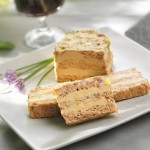 Our starter for the meal was a combination of
Our starter for the meal was a combination of 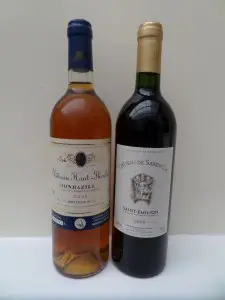 For the main course, we repeated a dish that had served us well at Christmas –
For the main course, we repeated a dish that had served us well at Christmas –  I have a niece called Rebecca who, a year or so ago, went to live in New Zealand with her new partner, Robin. Since then, we’ve all got to “know” Robin via Facebook, but none of us had actually met him. Rebecca decided to rectify this gap in our knowledge and she and Robin came to the Isle of Man to spend Christmas and New Year with her parents (my brother and his wife, Steve and Jeanette). And so, on Christmas day, we at last met Robin and discovered for ourselves what a really nice guy he is.
I have a niece called Rebecca who, a year or so ago, went to live in New Zealand with her new partner, Robin. Since then, we’ve all got to “know” Robin via Facebook, but none of us had actually met him. Rebecca decided to rectify this gap in our knowledge and she and Robin came to the Isle of Man to spend Christmas and New Year with her parents (my brother and his wife, Steve and Jeanette). And so, on Christmas day, we at last met Robin and discovered for ourselves what a really nice guy he is.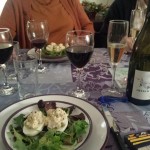 As a starter, we tried a little recipe of tuna-stuffed eggs which, I have to say, was rather uninspiring and it’s one we won’t be repeating.So, rushing past the bad news and onto the main course, we’d done one of our favourites,
As a starter, we tried a little recipe of tuna-stuffed eggs which, I have to say, was rather uninspiring and it’s one we won’t be repeating.So, rushing past the bad news and onto the main course, we’d done one of our favourites, 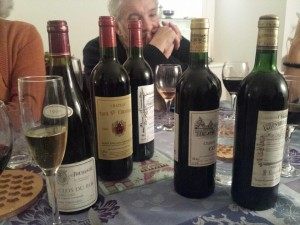 For Christmas, Marie-Danielle had bought me a case of Chateauneuf-du-Pape (both red and white) so, never being one to waste a good Christmas present, we enjoyed both the red and the white with this meal and it truly was a great Christmas gift (I even have a few bottles left!). Robin is a programmer and runs his own company,
For Christmas, Marie-Danielle had bought me a case of Chateauneuf-du-Pape (both red and white) so, never being one to waste a good Christmas present, we enjoyed both the red and the white with this meal and it truly was a great Christmas gift (I even have a few bottles left!). Robin is a programmer and runs his own company, 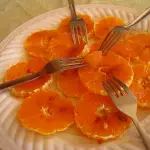 After a “Trou Normand” (calvados, served over sorbet) we moved on to the cheeseboard before actually celebrating the changing of the years and watching the London firworks on TV. After the last firwork had died out, we sat down to Orange Carpaccio with Gâteau Creusois which proved to be an excellent way to end a family New Year meal and welcome in another year of culinary delights!
After a “Trou Normand” (calvados, served over sorbet) we moved on to the cheeseboard before actually celebrating the changing of the years and watching the London firworks on TV. After the last firwork had died out, we sat down to Orange Carpaccio with Gâteau Creusois which proved to be an excellent way to end a family New Year meal and welcome in another year of culinary delights! The postscript to this pleasant evening was that, the following day, Robin and Rebecca braved the harsh Manx winter and took part in the New Year’s Day swim on Peel beach. Dressed as viking invaders, they did New Zealand proud! A couple of days later, they left the island and (going via England and Paris) they eventually found their way back to New Zealand with temperatures of 31ºC (91ºF)!
The postscript to this pleasant evening was that, the following day, Robin and Rebecca braved the harsh Manx winter and took part in the New Year’s Day swim on Peel beach. Dressed as viking invaders, they did New Zealand proud! A couple of days later, they left the island and (going via England and Paris) they eventually found their way back to New Zealand with temperatures of 31ºC (91ºF)! Last night we hosted a little dinner with some friends who have eaten with us before. It was actually a bit like an unofficial meeting of the conseil syndical de copropriété (the elected committee that help administer the day-to-day running of the apartment buildings). The conseil syndical ensures that lightbulbs are replaced, graffitti is painted over, cleaning is done properly, lifts work, doors and locks are maintained, and other stuff like that. They are elected each year at an AGM of all the owners and last night we had Yvon, Louis and M-D who are already on this committee, Pascale who is putting herself forward for election this year, Louis’ lovely wife, Monique, and of course, myself. So after a short spell on the balcony looking across the whole résidence (photo above), and then an aperitif in comfy chairs, we settled in for some serious eating!
Last night we hosted a little dinner with some friends who have eaten with us before. It was actually a bit like an unofficial meeting of the conseil syndical de copropriété (the elected committee that help administer the day-to-day running of the apartment buildings). The conseil syndical ensures that lightbulbs are replaced, graffitti is painted over, cleaning is done properly, lifts work, doors and locks are maintained, and other stuff like that. They are elected each year at an AGM of all the owners and last night we had Yvon, Louis and M-D who are already on this committee, Pascale who is putting herself forward for election this year, Louis’ lovely wife, Monique, and of course, myself. So after a short spell on the balcony looking across the whole résidence (photo above), and then an aperitif in comfy chairs, we settled in for some serious eating!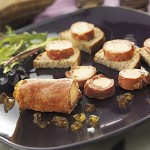 Starter was nice and simple – foie gras and roulades de Jambon au foie de canard en gelée au sauternes. And if you are wondering what that is, it’s foie gras rolled in ham which we get from
Starter was nice and simple – foie gras and roulades de Jambon au foie de canard en gelée au sauternes. And if you are wondering what that is, it’s foie gras rolled in ham which we get from 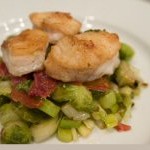 Main course was a repeat of something we have done before (for other people),
Main course was a repeat of something we have done before (for other people),  After a course of cheese and salad, for dessert, we served another of our old favourites,
After a course of cheese and salad, for dessert, we served another of our old favourites,  So to walk it all off, M-D and I went for an afternoon ‘constitutional’ along the river Seine this afternoon. The massive locks there are for the big barges that use the river (some of them up to 100m long) for moving mostly sand and shingle. It’s fascinating watching them manoeuvre into the locks which have a height difference of about 4 metres at this point.
So to walk it all off, M-D and I went for an afternoon ‘constitutional’ along the river Seine this afternoon. The massive locks there are for the big barges that use the river (some of them up to 100m long) for moving mostly sand and shingle. It’s fascinating watching them manoeuvre into the locks which have a height difference of about 4 metres at this point.  While walking, I spotted a brightly-coloured wood nymph! (see left).
While walking, I spotted a brightly-coloured wood nymph! (see left). At the weekend, we went up to Lille, where Christine lives and she trumped our Grenadin de Veau Gratiné with Magre de Canard (it’s not really a question of trying to outdo each other, because both recipes are drop-dead simple). Magre de Canard is duck breast – nothing more and nothing less. However, Christine roasted it and served it with a green pepper sauce and accompanied by sautée potatoes. It was more than splendid, it was rapture on a plate (and I ate far more than I should!)
At the weekend, we went up to Lille, where Christine lives and she trumped our Grenadin de Veau Gratiné with Magre de Canard (it’s not really a question of trying to outdo each other, because both recipes are drop-dead simple). Magre de Canard is duck breast – nothing more and nothing less. However, Christine roasted it and served it with a green pepper sauce and accompanied by sautée potatoes. It was more than splendid, it was rapture on a plate (and I ate far more than I should!) While we were in Lille, we visited the Roubaix swimming pool museum. This is the most amazing place, and has made use of a beautiful old Art Deco swimming pool that was due for demolition due to safety problems.
While we were in Lille, we visited the Roubaix swimming pool museum. This is the most amazing place, and has made use of a beautiful old Art Deco swimming pool that was due for demolition due to safety problems.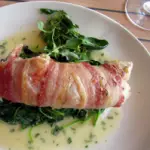 By way of marking our return to France, we invited our friends and neighbours, Terry, Julie, Dominic and Kate to dinner last night. We kicked off in normal style with a glass or two of Kir, using a rather nice Chardonny that had travelled back with us in January. When we settled at the table, we started with
By way of marking our return to France, we invited our friends and neighbours, Terry, Julie, Dominic and Kate to dinner last night. We kicked off in normal style with a glass or two of Kir, using a rather nice Chardonny that had travelled back with us in January. When we settled at the table, we started with 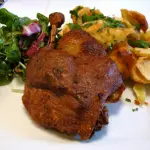 After which, we resorted to one of our regular favourites,
After which, we resorted to one of our regular favourites, 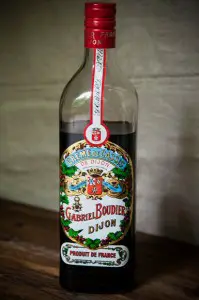 White wine with Crême de Cassis is known as “Kir” in France and is a popular apéritif drink named after Félix Kir (1876–1968), mayor of Dijon in Burgundy, who popularized the drink by offering it at receptions to visiting delegations. Besides treating his international guests well, he was also promoting two vital economic products of the region – blackcurrants and white wine.
White wine with Crême de Cassis is known as “Kir” in France and is a popular apéritif drink named after Félix Kir (1876–1968), mayor of Dijon in Burgundy, who popularized the drink by offering it at receptions to visiting delegations. Besides treating his international guests well, he was also promoting two vital economic products of the region – blackcurrants and white wine.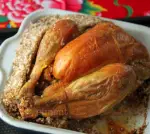 The main course was the “salty” end of the recipe with
The main course was the “salty” end of the recipe with  Once the chicken has been treated with the Boursin, you build a complete casing for it using coarse salt, flour, rosemary, thyme, baies, peppercorns and egg whites. It ends up looking like a bomb, but part of the fun of this recipe (and, yes, food should be fun too!) is, prior to serving, showing your guests the cooked “bomb” and seeing if any of them can guess what’s inside. Then, of course, you take it back to the kitchen and remove the salt crust (which takes a certain amount of brute force and muscle!)
Once the chicken has been treated with the Boursin, you build a complete casing for it using coarse salt, flour, rosemary, thyme, baies, peppercorns and egg whites. It ends up looking like a bomb, but part of the fun of this recipe (and, yes, food should be fun too!) is, prior to serving, showing your guests the cooked “bomb” and seeing if any of them can guess what’s inside. Then, of course, you take it back to the kitchen and remove the salt crust (which takes a certain amount of brute force and muscle!)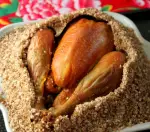 Once you have opened up the crust, you will find (every time without fail) a perfectly cooked golden brown bird, ready to be segmented and served in portions or, very simply, placed on a serving dish and carved at the table. We served ours with mini Brussels sprouts and new potatoes. No need for any sort of sauce or gravy, the moist chicken meat was more than enough – particularly when helped down with a couple of bottles of Domaine du Landetran, L’Ame des Schistes 2010 (well, come on, be fair, there were four of us!).
Once you have opened up the crust, you will find (every time without fail) a perfectly cooked golden brown bird, ready to be segmented and served in portions or, very simply, placed on a serving dish and carved at the table. We served ours with mini Brussels sprouts and new potatoes. No need for any sort of sauce or gravy, the moist chicken meat was more than enough – particularly when helped down with a couple of bottles of Domaine du Landetran, L’Ame des Schistes 2010 (well, come on, be fair, there were four of us!).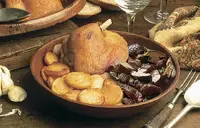 For the main course, we took an easy option (for us) and served
For the main course, we took an easy option (for us) and served 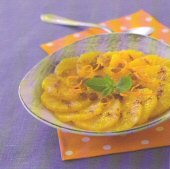 After a selection of cheeses (with a little more St Emilion!), dessert was a Gâteau Creusois and a Carpaccio d’Oranges à la Cannelle (Orange slices with cinnamon). Together, a nice simple, refreshing and tasty way to finish the meal (particularly since it took a new bottle of Saint Emilion to help it go down!).
After a selection of cheeses (with a little more St Emilion!), dessert was a Gâteau Creusois and a Carpaccio d’Oranges à la Cannelle (Orange slices with cinnamon). Together, a nice simple, refreshing and tasty way to finish the meal (particularly since it took a new bottle of Saint Emilion to help it go down!). Meanwhile, a combination of storms and high tides has given The Island a real pounding with many of the sea walls damaged, some shops and homes flooded and everybody huddled indoors waiting for summer! Fortunately, the island is hilly, so we don’t get many places where water lays on the land for long periods such as they are experiencing in Somerset.
Meanwhile, a combination of storms and high tides has given The Island a real pounding with many of the sea walls damaged, some shops and homes flooded and everybody huddled indoors waiting for summer! Fortunately, the island is hilly, so we don’t get many places where water lays on the land for long periods such as they are experiencing in Somerset. However, all’s well that ends well because Penny is coming round tomorrow night to help us finish the raclette ingredients that we had with Terry and Julie last week! We have just enough for three people, Steve’s away and Penny’s not on call, so it sounds like a good excuse to dig into the wine cellar and see what’s available – I love it when a plan comes together! Who cares about the weather?
However, all’s well that ends well because Penny is coming round tomorrow night to help us finish the raclette ingredients that we had with Terry and Julie last week! We have just enough for three people, Steve’s away and Penny’s not on call, so it sounds like a good excuse to dig into the wine cellar and see what’s available – I love it when a plan comes together! Who cares about the weather?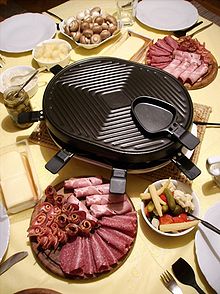 Obviously, we didn’t buy a 50kg block of cheese, light a fire and start scraping it – we used a more modern way of serving raclette that involves an electric table-top grill with small pans, known as coupelles, in which to melt slices of cheese. When we do this, we bring the cheese to the table already cut and sliced, along with a plate of charcuterie like Grisons (which is what we used last night) or pastrami or salami or cooked ham (or whatever floats your boat) accompanied by a big dish of boiled or steamed potatoes and a bowl of cornichons (small gherkins).
Obviously, we didn’t buy a 50kg block of cheese, light a fire and start scraping it – we used a more modern way of serving raclette that involves an electric table-top grill with small pans, known as coupelles, in which to melt slices of cheese. When we do this, we bring the cheese to the table already cut and sliced, along with a plate of charcuterie like Grisons (which is what we used last night) or pastrami or salami or cooked ham (or whatever floats your boat) accompanied by a big dish of boiled or steamed potatoes and a bowl of cornichons (small gherkins).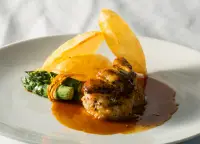 Even eating didn’t stop her talking, though it did slow her down a little as our lunch started with foie gras (as you do!) served with a lovely crisp 2005 Sauternes from Chateau Roumieu. Even M-D’s aunt showed a bit of respectful silence for that one! Following that, we got stuck into the main course of
Even eating didn’t stop her talking, though it did slow her down a little as our lunch started with foie gras (as you do!) served with a lovely crisp 2005 Sauternes from Chateau Roumieu. Even M-D’s aunt showed a bit of respectful silence for that one! Following that, we got stuck into the main course of 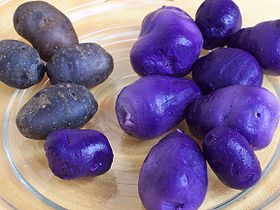 At this time of year, Vitelotte Potatoes (also called Vitelotte noire, Négresse or Truffe de Chine) are available in France. Vitelotte is a gourmet variety of blue-violet potato that has been cultivated in France since the early 19th century. In fact, they come in white, yellow, pink, red and violet, but the violet variety are the most common and, though they taste just the same as ordinary spuds, they are fun to use, offering a great alternative presentation on the plate.
At this time of year, Vitelotte Potatoes (also called Vitelotte noire, Négresse or Truffe de Chine) are available in France. Vitelotte is a gourmet variety of blue-violet potato that has been cultivated in France since the early 19th century. In fact, they come in white, yellow, pink, red and violet, but the violet variety are the most common and, though they taste just the same as ordinary spuds, they are fun to use, offering a great alternative presentation on the plate. The main course was served with an excellent Menetou-Salon which, though a red wine, is very light and can easily be served with fish. We skipped the cheese (having filled up on succulent monkfish) but Susanne had brought with her a hand-make chocolate cake from a pâtisserie near Versailles so we did some wilful damage to that, served with a glass or three of Mas Amiel Vintage.
The main course was served with an excellent Menetou-Salon which, though a red wine, is very light and can easily be served with fish. We skipped the cheese (having filled up on succulent monkfish) but Susanne had brought with her a hand-make chocolate cake from a pâtisserie near Versailles so we did some wilful damage to that, served with a glass or three of Mas Amiel Vintage.